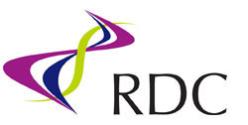Research Interests
Our lab is interested in a diverse and fascinating group of microorganisms called the streptomycetes, which are Gram-positive, filamentous bacteria that are ubiquitous in the environment. These microorganisms are known for their large, GC-rich, linear chromosomes and for their complex developmental life cycle that involves the formation of aerial hyphae structures and chains of spores. In addition, Streptomyces species are renowned for their ability to produce medically- and agriculturally- important secondary metabolites such as antibiotics, anti-viral, anti-fungal, herbicidal and immunosuppressive compounds. In fact, over two-thirds of the clinically-important natural products currently in use are produced by the streptomycetes! Most Streptomyces species are saphrophytes that degrade complex organic polymers and contribute to nutrient recycling in the environment. However, there are some species that also have the ability to infect living plant tissue and are the causative agents of economically-important crop diseases such as potato common scab.
Current areas of interest in the Bignell lab:
(1) Characterization of virulence-associated secondary metabolites produced by the common scab pathogen Streptomyces scabies. Of the 500 or more Streptomyces species that have been identified, only about a dozen or so have the ability to cause disease on plants. The best characterized plant pathogenic species, S. scabies, causes potato common scab, which is characterized by superficial, raised or pitted corky-like lesions that form on the potato tuber surface. These lesions affect the marketability of the potato crop and result in significant economic losses to potato growers. Other economically-important root crops are also susceptible to S. scabies infection including radish, beet, turnip and carrot.
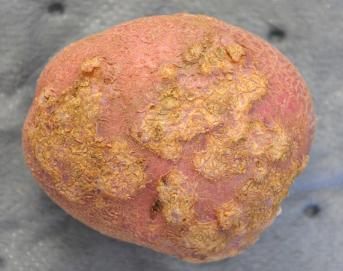
Scab disease symptoms on a potato tuber. Photo by D. Bignell.
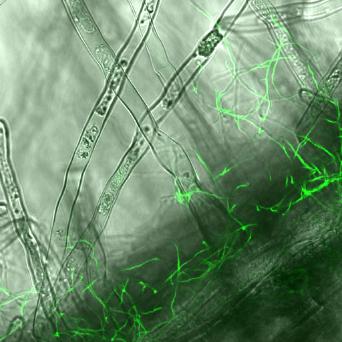
Colonization of radish seedling roots by GFP-labeled S. scabies. Photo by D. Bignell.
Our lab is interested in better understanding the molecular mechanisms of plant pathogenicity in S. scabies. In particular, we are interested in characterizing the secondary metabolites that are produced by S. scabies and which contribute to host-pathogen interactions. Current research in my lab is focused on elucidating the structure, biosynthesis, regulation and bioactivity of the virulence-associated COR-like metabolites, which are thought to resemble the coronatine (COR) phytotoxin produced by the plant pathogenic bacterium Pseudomonas syringae. Also, we are characterizing the biosynthesis of the principle S. scabies virulence factor, thaxtomin A, which is a nitrated dipeptide phytotoxin that is produced by several different pathogenic Streptomyces spp. In addition, we are currently studying several "orphan" secondary metabolite biosynthetic gene clusters in S. scabies in order to identify other virulence-associated secondary metabolites as well as metabolites that may play a role in the interaction of S. scabies with other microoganisms in the rhizosphere.
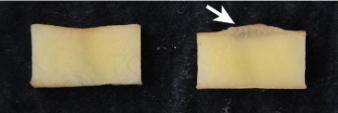 Hypertrophy of potato tuber tissue (right) caused by the S. scabies COR-like metabolites. The area of tissue hypertrophy is indicated by the white arrow. The control tuber tissue (left) shows no hypertrophy. Photo by J. Fyans.
Hypertrophy of potato tuber tissue (right) caused by the S. scabies COR-like metabolites. The area of tissue hypertrophy is indicated by the white arrow. The control tuber tissue (left) shows no hypertrophy. Photo by J. Fyans.
(2) Characterization of Streptomyces spp. causing potato common scab disease in Newfoundland. Common scab disease is one of the most important diseases affecting potato production in Newfoundland, and yet there is very little known regarding the Streptomyces spp. that are responsible for the disease on the island. Since 2011, we have been collecting scab-infected potatoes from different areas of Newfoundland, and we are in the process of isolating Streptomyces bacteria from the scab lesions in order to determine whether S. scabies is the predominant pathogen on the island or whether other species are responsible for the disease. Preliminary results from our lab suggest that there are novel plant pathogenic Streptomyces spp. causing common scab disease in Newfoundland and that these species are utilizing novel virulence factors other than thaxtomin A for inducing disease symptoms. We are continuing to characterize the pathogenic Streptomyces spp. that we have isolated, and we are also initiating studies on the virulence factors that are produced by the novel pathogenic species.
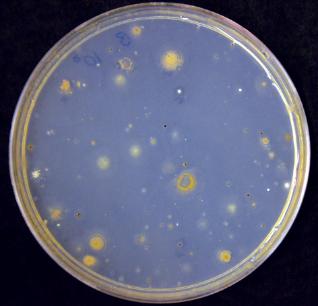
Colonies of Streptomyces isolated from common scab lesions on potato tubers harvested in Newfoundland. Photo by J. Fyans.
Research in the Bignell laboratory is supported by the following:



